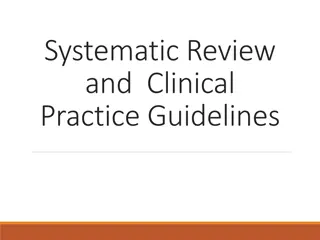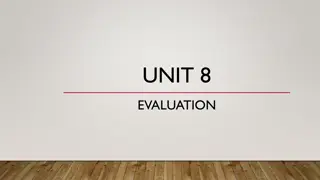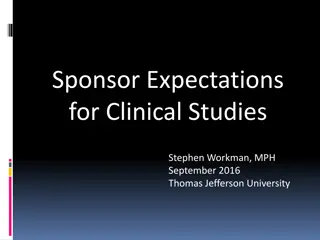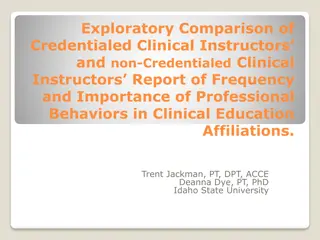Critical Evaluation of Clinical Studies and Guidelines
Understanding the need to critically evaluate studies, different study types aiding clinicians, bias and random errors affecting study outcomes, finding reliable studies, and the importance of meta-analyses in clinical practice guidelines. Emphasizing the significance of evidence-based decision-making for optimal patient care.
Download Presentation

Please find below an Image/Link to download the presentation.
The content on the website is provided AS IS for your information and personal use only. It may not be sold, licensed, or shared on other websites without obtaining consent from the author. Download presentation by click this link. If you encounter any issues during the download, it is possible that the publisher has removed the file from their server.
E N D
Presentation Transcript
PRACTICE GUIDELINES Barney Eskin TEACH BC Workshop 25 June 2017 No conflicts of interest to disclose.
OUTLINE OF THIS PRESENTATION Why do we need to critically evaluate studies? What are some types of studies that help the clinician? Do practitioners use studies to help care for patients? What are guidelines? How do we evaluate guidelines?
Why do we need to critically evaluate studies?
BIAS AND RANDOM ERROR Together contribute to uncertainty in studies The true direction of the effect The true magnitude of the effect Random error in studies depends on Size of the study Number of events Bias is systematic deviation from the truth. Depends on study design No study is entirely unbiased Researchers strive to decrease bias as much as possible Increasing study size does not decrease bias Critical evaluation of studies allows us to judge the amount of uncertainty resulting from bias.
What are some types of studies that help the clinician?
STUDY DESIGN Therapy Diagnosis Prognosis Harm Systematic Review/Metaanalysis Clinical Prediction/Decision Rule Clinical Practice Guideline Decision Analysis
FINDING STUDIES How do you find studies that help answer clinical questions? Google Google Scholar Medline/Pubmed Have all the information Enormous size makes it difficult to find what you want. Guidelines and Meta-analyses are your friends reliable summaries filtered resources These resources help you but you need to know how to use them.
META-ANALYSIS Systematically search for answers to a single question. In patients with strep throat, do antibiotics compared to no antibiotics result in faster resolution of symptoms? Where do I find them? Cochrane Collaboration Abstracts available in PubMed DARE (Database of Abstracts of Reviews of Effect) Journals Search for relevant studies needs to be exhaustive Each answer in a Practice Guideline should be based on a meta-analysis Already published OR Home-grown
CLINICAL PREDICTION RULES Elements of history, physical exam and simple tests are used to predict probability of disease Designed to reduce unnecessary testing/treatment Those with yes/no answers designed to not miss any or very few patients with disease Some give scores that correlate with risk Examples Wells Criteria for PE/DVT PERC rule Ottawa ankle, knee, C spine, head injury rules HEART score www.mdcalc.com
Do practioners use studies to help care for patients?
DONT FENCE ME IN Written in 1934 Music by Cole Porter Lyrics by Robert Fletcher and Cole Porter Recorded by Cole Porter Ella Fitzgerald 1956 Gene Autry 1956
DONT FENCE ME IN Oh, give me land, lots of land under starry skies Don't fence me in Let me ride through the wide country that I love Don't fence me in Oh, give me land, lots of land under starry skies above Don't fence me in Let me ride through the wide open country that I love Don't fence me in Let me be by myself in the evenin' breeze And listen to the murmur of the cottonwood trees Send me off forever but I ask you please Don't fence me in Let me be by myself in the evenin' breeze And listen to the murmur of the cottonwood trees Send me off forever but I ask you please Don't fence me in Just turn me loose, let me straddle my old saddle Underneath the western skies On my cayuse, let me wander over yonder Till I see the mountains rise Just turn me loose, let me straddle my old saddle Underneath the western skies On my cayuse, let me wander over yonder Till I see the mountains rise I want to ride to the ridge where the West commences And gaze at the moon till I lose my senses And I can't look at hobbles and I can't stand fences Don't fence me in, no Pop, oh don't you fence me in I want to ride to the ridge where the West commences And gaze at the moon till I lose my senses And I can't look at hobbles and I can't stand fences Don't fence me in
DONT FENCE ME IN Surveys of physicians about the use of Clinical Prediction Rules 95% of US physicians said they would use a headache rule if it were available CANADIAN ED DOCS Rule Canadian C spine Canadian head Aware 97% 86% Use 73% 57% Rates vary by country
CANADIAN CT HEAD RULE AWARE/USE
GUIDELINES Systematically Developed Statements Help with decisions to optimize patient care In specific clinical circumstances Developed by groups not individuals medical specialty association relevant professional society public or private organization government agency health care organization or plan
GUIDELINES Each addresses issues about a specific clinical entity Follow specific protocols Evidence vs. opinion Example: CPR guidelines Conflicts of interest
GUIDELINES.GOV National Guideline Clearinghouse AHRQ Agency for Healthcare Research and Quality Freely available CADTH Canadian Agency for Drugs and Technologies in Health Drugs and medical devices
NEW INCLUSION CRITERIA As of 2013 requires the following criteria to be included in guidelines.gov: Based upon a systematic review of the evidence. Must contain An assessment of the benefits and harms of the recommended care Alternative care options.
www.guidelines.gov Need to be updated periodically every 5-7 years? Allows you to view several guidelines side by side The quality of the evidence and the strength of recommendation are evaluated separately
QUALITY OF THE EVIDENCE ACEP CLASS Therapy 1 Diagnosis Prospective cohort with criterion standard Retrospective observational Case series Case report Other (consensus review) Prognosis Population prospective cohort RCT Meta-analysis 2 Non- randomized trial Case series Case report Other (consensus review) Retrospective cohort Case control Case series Case report Other (consensus review) 3
RECOMMENDATIONS ACEP Level A Generally accepted principles for patient management High degree of clinical certainty Based on Class I or Overwhelming evidence from Class II studies with directness Level B Particular strategy or range of strategies Moderate clinical certainty Based on Class II studies with directness Decision analysis with directness Strong consensus of Class III studies
RECOMMENDATIONS ACEP Level C Other strategies for patient management Based on Preliminary Inconclusive Conflicting evidence Panel consensus in absence of published literature
How do we evaluate guidelines?
EVALUATING GUIDELINES Tools are available GRADE Already mentioned Rigorous but you need to become familiarized with the methods SHAMELESS PLUG: GRADE track TEACH workshop NY Academy of Medicine August 2-4, 2017 AGREE Appraisal of Guidelines Research and Evaluation
GRADE Separates the Quality of the evidence Direction and strength of recommendations Example of oseltamivir for influenza
SIMPLIFIEDCRITERIA From Center for Evidence-Based Practice University of Pennsylvania Mitchell, Leas, Lavenberg, Goldmann, Umscheid
CRITERIA Transparency Conflict of interest Development group Systematic review Grading of evidence Recommendations External review Updating
SPECIFICS Transparency Are guideline development methods disclosed? Conflict of interest Is funding of the guideline disclosed? Are disclosures made for each author? Are there conflicts of interest? Does the guideline development group include Methodologic experts? Representatives of multiple specialties? Representatives of patients and the general public? Cervical spinal cord injury and steroids
SPECIFICS Systematic review Is the guideline based on evidence from systematic reviews? Grading of supporting evidence Is supporting evidence for each recommendation cited and graded? Recommendations Are benefits and harms of each recommendation presented? Are the strengths of each recommendation presented? Are recommendations actionable?
SPECIFICS External review Was the guideline available for review by external groups and the public? Updating and currency of the guideline Is the guideline current? Is the expiration date given? Is the update process specified?























